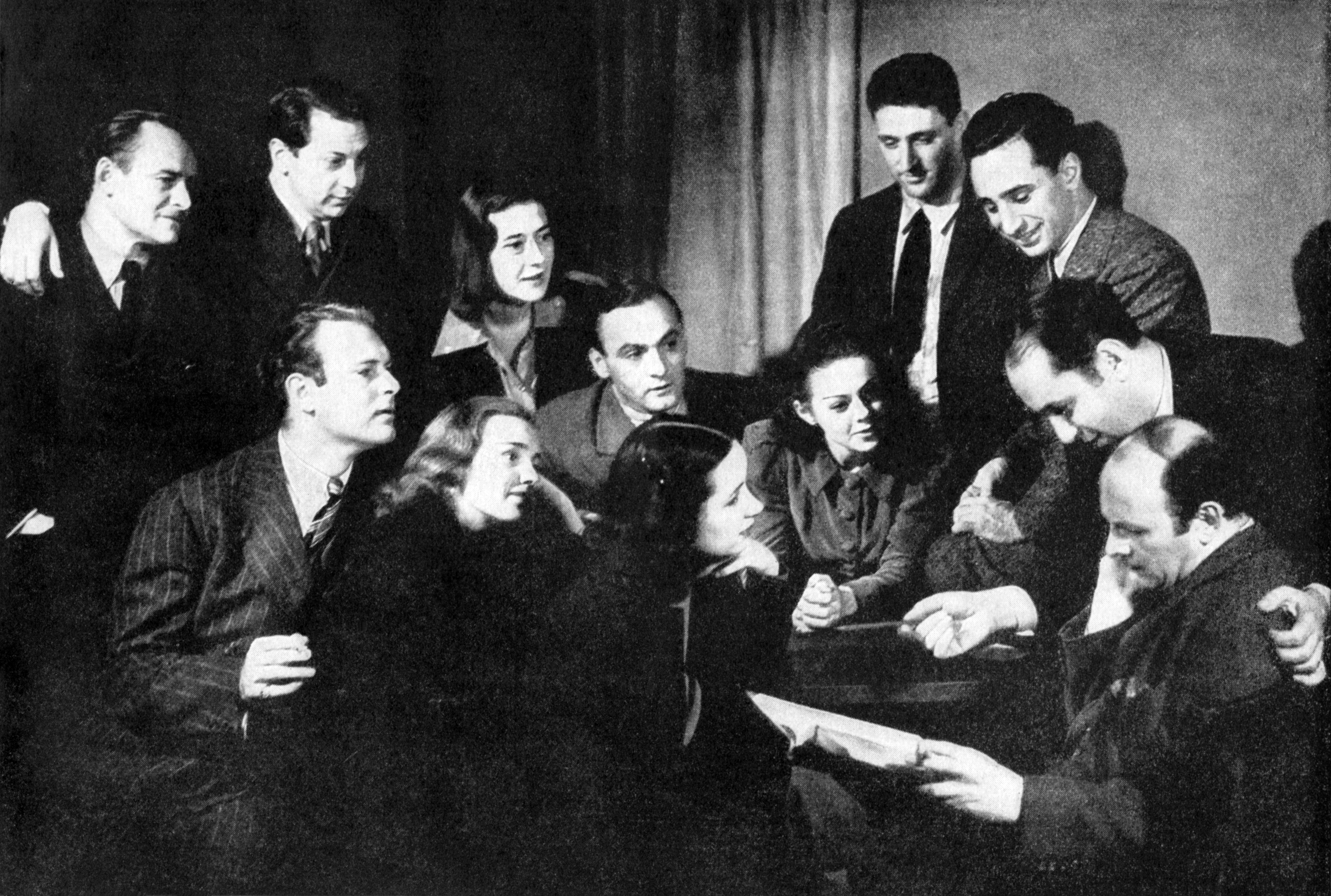|
American Laboratory Theatre
The American Laboratory Theatre was an American drama school and theatrical company located in New York City that existed during the 1920s and 1930s. It was a publicly subsidized, student-subscription organization that held fund-raising campaigns to support itself. History The school itself was known as the Theatre Arts Institute. It was founded in 1923 by former Moscow Art Theatre members Richard Boleslavsky and Maria Ouspenskaya and stressed Stanislavski's system as its teaching method. Students were taught to be uninhibited, with exercises such as acting as a fish under water, a melting ice cream cone, or (for women) the mother of a sick child praying to the Madonna. Both actors and directors were trained, and Boleslavsky and Ouspenskaya became known as the leading promulgators of Stanislavski's ideas in America. Some five hundred students were trained at the school during its years of existence. These included Lee Strasberg, Harold Clurman, and Stella Adler, all of whom wo ... [...More Info...] [...Related Items...] OR: [Wikipedia] [Google] [Baidu] |
New York City
New York, often called New York City (NYC), is the most populous city in the United States, located at the southern tip of New York State on one of the world's largest natural harbors. The city comprises five boroughs, each coextensive with a respective county. The city is the geographical and demographic center of both the Northeast megalopolis and the New York metropolitan area, the largest metropolitan area in the United States by both population and urban area. New York is a global center of finance and commerce, culture, technology, entertainment and media, academics, and scientific output, the arts and fashion, and, as home to the headquarters of the United Nations, international diplomacy. With an estimated population in 2024 of 8,478,072 distributed over , the city is the most densely populated major city in the United States. New York City has more than double the population of Los Angeles, the nation's second-most populous city. [...More Info...] [...Related Items...] OR: [Wikipedia] [Google] [Baidu] |
Richard Aldrich (producer)
Richard Stoddard Aldrich (August 17, 1902March 31, 1986) was an American theatre producer, theatre manager, director, and diplomat. He was an officer with the United States Navy reserves during World War II and the Korean War, and a diplomat with the United States Foreign Operations Administration and International Cooperation Administration. He produced more than thirty plays on Broadway from 1933 through 1956, and also operated three summer theaters in Massachusetts. He was married to the actress Gertrude Lawrence until her death; their marriage was memorialized in his book ''Gertrude Lawrence as Mrs. A: An Intimate Biography of a Great Star'' (1955) and the Oscar nominated biographical musical film '' Star!'' (1968). Life and career Aldrich was born in Boston, and graduated from Harvard University in 1925. At Harvard he served a term as president of the Harvard Radcliffe Dramatic Club and was a founding member of The Jitney Players in 1923. In 1926 he became general manag ... [...More Info...] [...Related Items...] OR: [Wikipedia] [Google] [Baidu] |
Educational Institutions Disestablished In 1933
Education is the transmission of knowledge and skills and the development of character traits. Formal education occurs within a structured institutional framework, such as public schools, following a curriculum. Non-formal education also follows a structured approach but occurs outside the formal schooling system, while informal education involves unstructured learning through daily experiences. Formal and non-formal education are categorized into levels, including early childhood education, primary education, secondary education, and tertiary education. Other classifications focus on teaching methods, such as teacher-centered and student-centered education, and on subjects, such as science education, language education, and physical education. Additionally, the term "education" can denote the mental states and qualities of educated individuals and the academic field studying educational phenomena. The precise definition of education is disputed, and there are disagreements ... [...More Info...] [...Related Items...] OR: [Wikipedia] [Google] [Baidu] |
Culture Of New York City
New York City has been described as the cultural capital of the world. Its urban culture is reflected in its size and ethnic diversity. As many as 800 languages are spoken in New York, making it the most linguistically diverse city in the world. Many American cultural movements first emerged in the city. Large numbers of Irish, Italian, Jewish, and eventually African, Latino, and Asian Americans also migrated to New York throughout the 20th century and continuing into the 21st century, significantly influencing the city's culture and image. The city became the center of stand-up comedy in the early 20th century. The city was the top venue for jazz in the 1940s, expressionism in the 1950s and home to hip hop, punk rock, and the Beat Generation. Along with London, New York City is the global center of musical theatre, often referred to as " Broadway" after the major thoroughfare in Manhattan. The Stonewall Inn in Greenwich Village, Lower Manhattan, is a designated U.S. Natio ... [...More Info...] [...Related Items...] OR: [Wikipedia] [Google] [Baidu] |
Education In Manhattan
Education is the transmission of knowledge and skills and the development of character traits. Formal education occurs within a structured institutional framework, such as public schools, following a curriculum. Non-formal education also follows a structured approach but occurs outside the formal schooling system, while informal education involves unstructured learning through daily experiences. Formal and non-formal education are categorized into levels, including early childhood education, primary education, secondary education, and tertiary education. Other classifications focus on teaching methods, such as teacher-centered and student-centered education, and on subjects, such as science education, language education, and physical education. Additionally, the term "education" can denote the mental states and qualities of educated individuals and the academic field studying educational phenomena. The precise definition of education is disputed, and there are disagreements ... [...More Info...] [...Related Items...] OR: [Wikipedia] [Google] [Baidu] |
Drama Schools In The United States
Drama is the specific mode of fiction represented in performance: a play, opera, mime, ballet, etc., performed in a theatre, or on radio or television.Elam (1980, 98). Considered as a genre of poetry in general, the dramatic mode has been contrasted with the epic and the lyrical modes ever since Aristotle's ''Poetics'' ()—the earliest work of dramatic theory. The term "drama" comes from a Greek word meaning "deed" or " act" (Classical Greek: , ''drâma''), which is derived from "I do" (Classical Greek: , ''dráō''). The two masks associated with drama represent the traditional generic division between comedy and tragedy. In English (as was the analogous case in many other European languages), the word ''play'' or ''game'' (translating the Anglo-Saxon ''pleġan'' or Latin ''ludus'') was the standard term for dramas until William Shakespeare's time—just as its creator was a ''play-maker'' rather than a ''dramatist'' and the building was a ''play-house'' rather than a '' ... [...More Info...] [...Related Items...] OR: [Wikipedia] [Google] [Baidu] |
Group Theatre (New York)
The Group Theatre was a theater collective based in New York City and formed in 1931 by Harold Clurman, Cheryl Crawford and Lee Strasberg. It was intended as a base for the kind of theatre they and their colleagues believed in—a forceful, naturalistic and highly disciplined artistry. They were pioneers of what would become an "American acting technique", derived from the teachings of Konstantin Stanislavski, but pushed beyond them as well. The company included actors, directors, playwrights, and producers. The name "Group" came from the idea of the actors as a pure ensemble; a reference to the company as "our group" led them to "accept the inevitable and call their company The Group Theatre."Clurman, p. 51 The New York–based Group Theatre had no connection with the identically named Group Theatre based in London and founded in 1932. In the ten years of its existence, the Group Theatre produced works by many important American playwrights, including Clifford Odets, Sid ... [...More Info...] [...Related Items...] OR: [Wikipedia] [Google] [Baidu] |
Maria Germanova
Maria Nikolayevna Krasovskaya-Kalitinskaya (, née Bychkova (), 1884 – 9 April 1940) was a Russian actress, theatre director and reader in drama, better known under her stage name Maria Germanova ().Мария Николаевна Германова Profile at mxat.ru, the Moscow Art Theatre site Biography Maria Bychkova was born in Moscow into a family of the staroobryadtsy merchants. She studied at the First Moscow Gymnasium, where Olga Gzovskaya was one of her classmates. In 1901 she enrolled in the just opened Moscow Art Theatre Drama School and a year later joined the MAT troupe, as Maria Ge ...[...More Info...] [...Related Items...] OR: [Wikipedia] [Google] [Baidu] |
Arthur Schnitzler
Arthur Schnitzler (15 May 1862 – 21 October 1931) was an Austrian author and dramatist. He is considered one of the most significant representatives of Viennese Modernism. Schnitzler’s works, which include psychological dramas and narratives, dissected turn-of-the-century Viennese bourgeois life, making him a sharp and stylistically conscious chronicler of Viennese society around 1900. Schnitzler's Jewish upbringing and the sexual content of his works made them controversial or banned in his time and beyond. Life Arthur Schnitzler was born at Praterstrasse 16, Leopoldstadt, Vienna, capital of the Austrian Empire (as of 1867, part of the dual monarchy of Austria-Hungary). He was the son of a prominent Hungarian laryngologist, Johann Schnitzler (1835–1893), and Luise Markbreiter (1838–1911), a daughter of the Viennese doctor Philipp Markbreiter. His parents were both from Jewish families. In 1879 Schnitzler began studying medicine at the University of Vienna and in 18 ... [...More Info...] [...Related Items...] OR: [Wikipedia] [Google] [Baidu] |
Jean-Jacques Bernard
Jean-Jacques Bernard (30 July 1888 – 14 September 1972) was a French playwright and the chief representative of what became known as ''l’école du silence'' or, as some critics called it, the ''art of the unexpressed'', in which the dialogue does not express the characters’ real attitudes. In ''Martine'' (1922), perhaps the best example of his work, emotions are implied in gestures, facial expressions, fragments of speech and silence. He was active from 1912 to 1939. Bernard was born in Enghien-les-Bains, Val-d'Oise, the son of the dramatist Tristan Bernard. As a Jew, he was interned for a period of months starting in December 1941 in Compiègne, at a camp where 50,000 Jews were deported to concentration camps. Bartov, Omer; and Mack, Phyllis''In God's name: genocide and religion in the twentieth century'' p. 310. Berghahn Books Berghahn Books is a New York and Oxford–based publisher of scholarly books and academic journals in the humanities and social sciences, with a ... [...More Info...] [...Related Items...] OR: [Wikipedia] [Google] [Baidu] |
Anton Chekhov
Anton Pavlovich Chekhov (; ; 29 January 1860 – 15 July 1904) was a Russian playwright and short-story writer, widely considered to be one of the greatest writers of all time. His career as a playwright produced four classics, and his best short stories are held in high esteem by writers and critics. Along with Henrik Ibsen and August Strindberg, Chekhov is often referred to as one of the three seminal figures in the birth of early modernism in the theatre. Chekhov was a physician by profession. "Medicine is my lawful wife," he once said, "and literature is my mistress." Chekhov renounced the theatre after the reception of ''The Seagull'' in 1896, but the play was revived to acclaim in 1898 by Konstantin Stanislavski's Moscow Art Theatre, which subsequently also produced Chekhov's ''Uncle Vanya'' and premiered his last two plays, ''Three Sisters (play), Three Sisters'' and ''The Cherry Orchard''. These four works present a challenge to the acting ensemble as well as to a ... [...More Info...] [...Related Items...] OR: [Wikipedia] [Google] [Baidu] |






